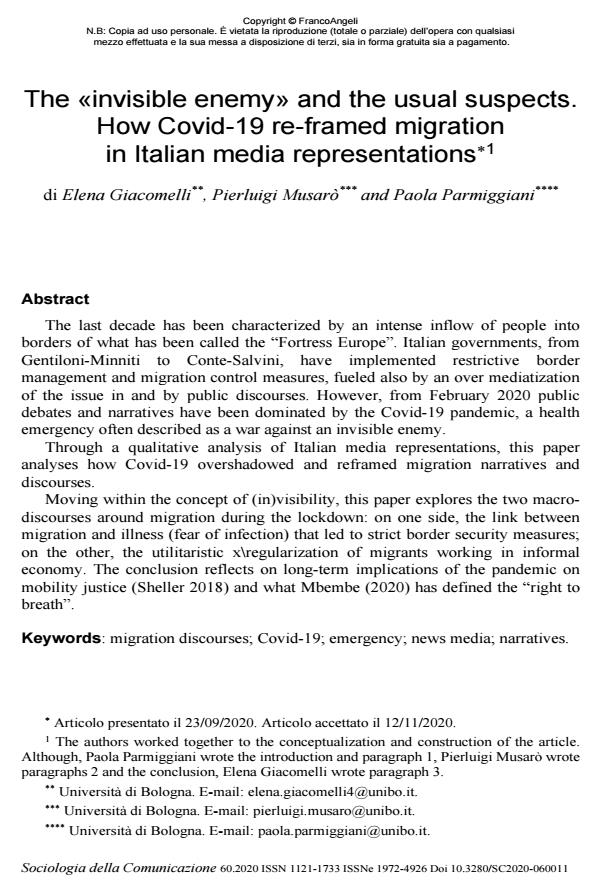The «invisible enemy» and the usual suspects. How Covid-19 re-framed migration in Italian media representations
Journal title SOCIOLOGIA DELLA COMUNICAZIONE
Author/s Elena Giacomelli, Pierluigi Musarò, Paola Parmiggiani
Publishing Year 2021 Issue 2020/60
Language English Pages 18 P. 119-136 File size 242 KB
DOI 10.3280/SC2020-060011
DOI is like a bar code for intellectual property: to have more infomation
click here
Below, you can see the article first page
If you want to buy this article in PDF format, you can do it, following the instructions to buy download credits

FrancoAngeli is member of Publishers International Linking Association, Inc (PILA), a not-for-profit association which run the CrossRef service enabling links to and from online scholarly content.
The last decade has been characterized by an intense inflow of people into borders of what has been called the "Fortress Europe". Italian governments, from Gentiloni-Minniti to Conte-Salvini, have implemented restrictive border management and migration control measures, fueled also by an over mediatization of the issue in and by public discourses. However, from February 2020 public debates and narratives have been dominated by the Covid-19 pandemic, a health emergency often described as a war against an invisible enemy. Through a qualitative analysis of Italian media representations, this paper analyses how Covid-19 overshadowed and reframed migration narratives and discourses. Moving within the concept of (in)visibility, this paper explores the two macrodiscourses around migration during the lockdown: on one side, the link between migration and illness (fear of infection) that led to strict border security measures; on the other, the utilitaristic x\regularization of migrants working in informal economy. The conclusion reflects on long-term implications of the pandemic on mobility justice (Sheller 2018) and what Mbembe (2020) has defined the "right to breath".
Keywords: Migration discourses; Covid-19; emergency; news media; narratives.
- Quarantine Ships as Spaces of Bordering: The Securitization of Migration Policy in Italy During the COVID-19 Pandemic Nicola Montagna, in International Migration Review /2024 pp.499
DOI: 10.1177/01979183231154560 - The Panicocene in Italian media. Discourse analysis of climate migration narratives Elena Giacomelli, in Journal of Information, Communication and Ethics in Society /2025
DOI: 10.1108/JICES-06-2025-0143 - The Emergence of New Street-Level Bureaucracies in Italy’s Asylum Reception System Elena Giacomelli, in Journal of Immigrant & Refugee Studies /2021 pp.272
DOI: 10.1080/15562948.2021.1939471 - Viral bodies: racialised and gendered logics in the securitisation of migration during COVID-19 in Italy Agnese Pacciardi, in Critical Studies on Security /2023 pp.176
DOI: 10.1080/21624887.2023.2248437 - Climate Mobility Justice Elena Giacomelli, Pierluigi Musarò, pp.73 (ISBN:978-3-032-07906-0)
- Da "angeli del mare" a "complici dei trafficanti": la politicizzazione del discorso sovranista contro le ONG umanitarie Dario Lucchesi, Andrea Cerase, in MONDI MIGRANTI 2/2023 pp.153
DOI: 10.3280/MM2023-002009 - Attitudes towards migrants and preferences for asylum and refugee policies before and during russian invasion of ukraine: The case of slovakia Magdalena Adamus, Matúš Grežo, in Comparative Migration Studies 44/2024
DOI: 10.1186/s40878-024-00405-z
Elena Giacomelli, Pierluigi Musarò, Paola Parmiggiani, The «invisible enemy» and the usual suspects. How Covid-19 re-framed migration in Italian media representations in "SOCIOLOGIA DELLA COMUNICAZIONE " 60/2020, pp 119-136, DOI: 10.3280/SC2020-060011